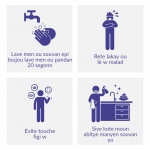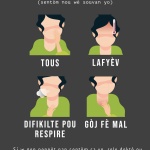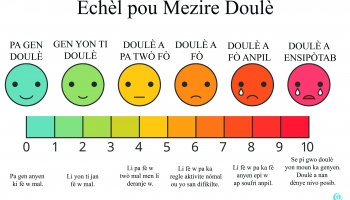COVID-19 Vocabulary in Haitian Creole
Vokabilè Kowonaviris an Anglè
| English (Angle) | Haitian Creole (Kreyòl) |
| To fall ill, to get sick | Tonbe malad |
| Flu | Grip
Lagrip Grip sezon |
| Cold | Rim |
| Fever | Lafyèv
Fyèv |
| Wash your hands | Lave men ou |
| Wash your face | Lave figi ou |
| Take your medicine | Pran medikaman ou
Pran remèd ou |
| Hospital | Lopital |
| Doctor | Doktè |
| Nurse | Enfimyè |
| Face mask | Mask pou figi |
| To cough | Touse |
| Cough | Tous |
| Dry cough | Tous sèk |
| Shortness of breath | Souf kout |
| Sneeze | Estène |
| Infection | Enfeksyon |
| Virus | Viris |
| Prevent | Kwape
Anpeche |
| Outbreak | Eklatman |
| Epidemic | Epidemi |
| Pandemic | Pandemi |
| Isolation | Izolman |
| Confinement | Konfinman |
| Quarantine | Karantèn |
| Vaccine | Vaksen |



